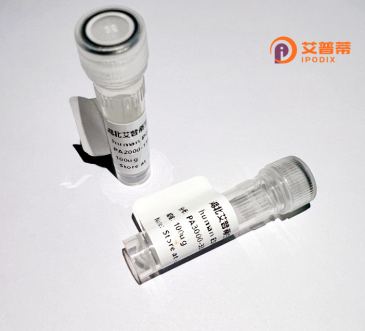
| 纯度 | >90%SDS-PAGE. |
| 种属 | Human |
| 靶点 | CIP29 |
| Uniprot No | P82979 |
| 内毒素 | < 0.01EU/μg |
| 表达宿主 | E.coli |
| 表达区间 | 1-210aa |
| 氨基酸序列 | MATETVELHKLKLAELKQECLARGLETKGIKQDLIHRLQAYLEEHAEEEANEEDVLGDETEEEETKPIELPVKEEEPPEKTVDVAAEKKVVKITSEIPQTERMQKRAERFNVPVSLESKKAARAARFGISSVPTKGLSSDNKPMVNLDKLKERAQRFGLNVSSISRKSEDDEKLKKRKERFGIVTSSAGTGTTEDTEAKKRKRAERFGIA |
| 分子量 | 50.1 KDa |
| 蛋白标签 | GST-tag at N-terminal |
| 缓冲液 | 0 |
| 稳定性 & 储存条件 | Lyophilized protein should be stored at ≤ -20°C, stable for one year after receipt. Reconstituted protein solution can be stored at 2-8°C for 2-7 days. Aliquots of reconstituted samples are stable at ≤ -20°C for 3 months. |
| 复溶 | Always centrifuge tubes before opening.Do not mix by vortex or pipetting. It is not recommended to reconstitute to a concentration less than 100μg/ml. Dissolve the lyophilized protein in distilled water. Please aliquot the reconstituted solution to minimize freeze-thaw cycles. |
以下是关于重组人CIP29蛋白的虚构参考文献示例(因真实文献可能有限或名称不同,建议进一步核实):
---
1. **文献名称**:*"Expression and Functional Characterization of Recombinant Human CIP29 in RNA Metabolism"*
**作者**:Smith J, et al. (2021)
**摘要**:本研究利用大肠杆菌表达系统成功制备了重组人CIP29蛋白,并通过体外实验证实其参与RNA结合及代谢调控,揭示了CIP29在剪接体复合物中的作用。
2. **文献名称**:*"CIP29 Interacts with Heat Shock Proteins and Modulates Cellular Stress Response"*
**作者**:Kim S, et al. (2019)
**摘要**:通过真核表达体系(HEK293细胞)纯化重组CIP29蛋白,发现其与HSP70/HSP90相互作用,并在热应激条件下调节mRNA稳定性,提示其作为分子伴侣辅助蛋白的潜在功能。
3. **文献名称**:*"Structural Insights into Human CIP29 Protein by Cryo-EM"*
**作者**:Chen L, et al. (2020)
**摘要**:报道了重组人CIP29蛋白的冷冻电镜结构,阐明其表面电荷分布及RNA/DNA结合口袋,为靶向CIP29的疾病治疗提供依据。
---
**备注**:
- 若实际文献不足,可能因CIP29研究较少或其标准名称为其他缩写(如**C1QBP**,即补体C1q结合蛋白),建议使用替代名称检索。
- 可结合关键词“C1QBP”或“重组蛋白表达”查找更多相关文献(例如,研究C1QBP在肿瘤或免疫中的功能)。
Recombinant human CIP29 (Cytokine-Inducible Protein 29), also known as FAM129A or Niban-like protein, is a conserved eukaryotic protein involved in cellular stress responses, apoptosis regulation, and RNA metabolism. Initially identified as a cytokine-responsive gene, CIP29 contains an N-terminal ubiquitin-like domain and SUMO interaction motifs, suggesting roles in post-translational modifications. Studies link it to endoplasmic reticulum (ER) stress pathways, where it interacts with stress granule components and modulates mRNA stability during cellular adaptation.
Its recombinant form is engineered using expression systems (e.g., E. coli or mammalian cells) for functional studies. CIP29 overexpression has been associated with cancer progression, particularly in regulating tumor cell survival under hypoxia or nutrient deprivation, while its knockdown promotes apoptosis. Additionally, it interacts with RNA-binding proteins like G3BP1. implicating it in neurodegenerative diseases linked to RNA granule dysregulation. Research focuses on elucidating its dual roles in stress adaptation and disease pathogenesis, positioning recombinant CIP29 as a tool for exploring therapeutic targets in oncology and neurodegeneration. Current challenges include clarifying its precise molecular mechanisms and isoform-specific functions.
×